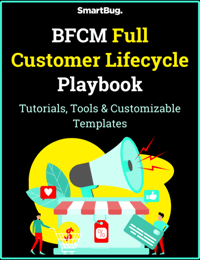
Hemp and CBD Marketing: Compliance, Education, and Differentiation
September 6, 2024
The cannabis, hemp, and CBD sector is one of the trickiest markets to navigate as an e-commerce brand. Inventions, organizations, regulations, and misconceptions emerge and fluctuate constantly, so naturally marketing best practices are changing every day. How can today’s companies successfully navigate this uncertainty?
As a brand in this evolving e-commerce space, your priority should be to build trust and authority with your audience. Ignoring compliance efforts puts your brand at risk of getting flagged, fined, or suspended from ad platforms, which puts your whole reputation on the line. There are regulations in place for a reason, so be sure to protect your customers and your brand—with some help from SmartBug!
Introduction to CBD and Hemp E-Commerce Marketing
Some quick background: cannabidiol (CBD) is a phytocannabinoid with therapeutic benefits derived from the hemp plant. Hemp and cannabis are the same plant, but hemp contains 0.3 percent or less THC (the psychoactive phytocannabinoid in cannabis). Extracted as an oil, CBD is then added to various consumer goods ranging from topical lotions and gummies to beverages and dog treats. CBD marketing, however, is notoriously tricky thanks to the product’s association with federally restricted cannabis (marijuana).
Industry-Specific Challenges and Opportunities
Hemp-derived CBD marketing poses some challenges because of market volatility. Often, this volatility is triggered by the hazy status surrounding CBD legality—local, state, and federal laws are shifting constantly, as are public opinions about its consumers.
Additionally, the CBD and hemp e-commerce market is highly regulated, and regulations differ drastically from state to state. Marketers must ensure they’re staying up to date and following best practices, including age gating and avoiding health claims or untested assumptions.
Despite these pervasive challenges, Grand View Research reports the global CBD market size was valued at nearly $8 billion in 2023, and is “expected to grow at a compound annual growth rate of 15.8 percent from 2024 to 2030.” This growth will unlock huge opportunities for brands in this sector and can be attributed to the increasing legalization of hemp- and cannabis-based products as well as expanding recognition of their therapeutic benefits.
Understanding and Navigating Compliance
All eyes are on the cannabis industry as it continues to grow (no pun intended) and evolve into a mainstream market. Regulations in this space are strict, not to mention challenging to keep up with. All messages must comply with a handful of rules and restrictions, which is especially important when planning for high-volume periods or events (such as Black Friday and Cyber Monday, when words like “sale” and “discount” are likely to be associated with your offering and thus more likely to be flagged).
Varying Guidelines by Digital Marketing Channel
Especially when it comes to highly regulated industries, not all marketing channels are created equal in terms of messaging compliance. They all have their own rules and guidelines regarding advertising messaging on their platforms that can affect deliverability. Let’s take a look at a few common ones:
Information gathered as of September 2024.
|
Marketing Channel |
Marketing Messages Allowed? |
Explanation |
|
|
Yes, with age gating |
All email correspondence relating to cannabis and hemp advertising must be age gated to exclude those under the age of 21 from receiving messages. If your e-commerce site is age gated, which it should be, then you’re good to go as long as you receive consent! |
|
SMS |
No |
In the U.S. and Canada, certain message content is prohibited and should be avoided, no matter where you are sending. This includes (but isn’t limited to) potentially illicit substances, gambling, and political content. Individual wireless carriers also have their own rules for what they will allow and will reject messages containing prohibited content. |
|
Google Ads |
No* |
Even though cannabis is legal on some level in more states than not, Google maintains strict advertising prohibition. Google has policies against cannabis because it categorizes cannabis and its derivatives as drugs that alter mental state. |
|
Meta |
Yes, with express written permission |
Certified advertisers (those that possess an approved LegitScript certification) must comply with all applicable local laws, codes, and guidelines, including Meta’s targeting requirements. Ads may only promote or offer the sale of CBD in the U.S. and must not be targeted to people under 18 years of age. Ads may only offer the sale of hemp products in Canada, Mexico, and the U.S. Finally, you must receive written permission from Meta to run any paid advertisements. |
*Google only scans your ad copy and website for the previously mentioned “trigger” words, but it does not do the same for bidding on cannabis keywords. In other words, this means that you can bid for the word “marijuana,” but you cannot use it in your ad copy or your website.
It’s also not unheard of for a company to create an entirely new website that acts as a landing site for its ads. This website is usually not all that robust and is totally free of violating terminology. The site is often one that the brand doesn’t mind losing or abandoning if needed.
Effective Alternative Marketing Strategies
Fortunately, as you know, the above channels aren’t the only options available to e-commerce marketers. Some other digital marketing opportunities include:
- SEO strategies
- Organic social media
- Third-party ad hosting (such as Weedmaps or Leafly)
- Google Business Profile Listing
Educating Your Audience
Educational content promotes awareness, plus it can help close knowledge gaps and combat misinformation. Because CBD and hemp products are newly legal in many areas, many myths and preconceived notions exist. It’s important that customers feel confident in the product’s safety and effectiveness. Educational content can help your brand turn CBD acceptors into CBD users.
Brands can utilize blog posts, white papers, FAQs, videos, and infographics to inform and educate consumers. This content should detail the benefits, uses, and safety of CBD and hemp products by leveraging credible sources and scientific research. Use this content to explain to consumers:
- Where your product is sourced
- Different ways to enjoy your product
- How to stay safe while consuming your product
- What’s new in the industry
Any way you can increase your consumers’ knowledge of your product and the industry as a whole will help to cultivate authority and trust. Consider creating a database of reliable resources to turn to for ideas and inspiration that you and your audience can trust.
Building Transparency and Trust
In any industry where a product is manufactured and consumed, consumers expect superior product quality, transparency, and safety. Whether a business sells food, beverages, beauty products, or pharmaceuticals, consumers expect to be able to see what’s in these products and where they come from.
If you’re not transparent about your sourcing, manufacturing processes, and testing procedures, or if you neglect to provide clear and accurate information about your products, you risk being seen as a non-reputable company in the industry. This can impact consumers’ willingness to purchase from you.
Here are a few ways to build that essential trust with your audience within the hemp and CBD sector:
- Display lab results and clear ingredient lists on your website.
- Apply for a LegitScript CBD Certification to build trust with consumers. This certification proves your CBD products check all the boxes: third-party tested, FDA-compliant, and free of impermissible levels of THC.
- Make sure all claims made in any original content are authentic, substantiated, and supported by credible sources.
Balancing Creativity and Compliance
Initially, trying to follow all of these regulations and guidelines may seem to stifle your marketing team’s winning creativity. It’s okay to feel a bit defeated at first! But the good news is that even in these limitations, there’s plenty of potential for your top-notch team to discover all-new (compliant) ways to promote your amazing products and learn to thrive in a complicated market.
To get you started, here are a few of our pro tips for striking the balance between creativity and compliance:
- Keep teams informed about the latest compliance developments by providing regular training sessions and office hours to both creative and legal teams.
- Establish review and approval processes so teams can minimize unnecessary delays and ensure that compliance checks are conducted in a timely manner.
- Involve legal perspectives and expertise in brainstorming sessions and creative briefings from the beginning so potential compliance issues can be identified and addressed proactively.
Setting the Standard for Hemp and CBD Marketing
A huge component of CBD marketing is ensuring all marketing messages are trustworthy, transparent, and truthful. Laws and local regulations are still catching up to technology, and it’s up to e-commerce professionals to set the standard for this emerging industry. Building trust and awareness based on authentic, reputable information is the best way to establish and maintain a high standard.
Marketing hemp and CBD is tricky—but it’s not impossible. To get you started with ideas for Black Friday and Cyber Monday this year, check out our best practices playbook.
Disclaimer: This information contained is accurate at the time of writing (August 2024). However, information pertaining to CBD advertising and marketing is subject to change, depending on whether or not advertisers decide to amend their rules in the foreseeable future.

Tutorials, Tools, & Customizable Templates
Skyrocket BFCM revenue with our Full Customer Lifecycle Playbook

About the author
Emily Bongiovanni is an E-Commerce Marketing Strategist at SmartBug. She has a passion for driving growth and delivering exceptional results with data-driven strategies. With over 8 years of experience in the dynamic world of marketing, she has a proven track record of helping businesses excel in the digital realm. When she's not strategizing or analyzing, you can find her walking her Australian Shepherd, hiking, or tackling a DIY project at home. Read more articles by Emily Bongiovanni.




